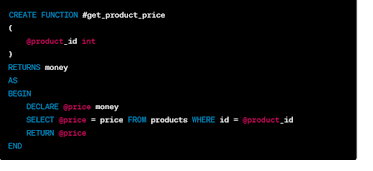Let’s consider a table named “employees” with the following columns: employee_id, first_name, last_name, department, and salary. We can create a temporary function that calculates the average salary for a given department, as follows:
CREATE FUNCTION ##Average_Salary
(
@Dept VARCHAR(50)
)
RETURNS DECIMAL (18,2)
AS
BEGIN
DECLARE @Result DECIMAL(18,2);
SELECT @Result = AVG(Salary)
FROM EMPLOYEES
WHERE Department = @Dept;
RETURN @Result;
END
- Once the function is created, we can call it using the following query:
SELECT ##Average_Salary(‘Sales’) AS Avg_Salary_Sales; This query will return the average salary for the sales department.
Applications of Temporary Functions: - Temporary functions can be used in a variety of scenarios to perform complex calculations or manipulations on data that are not possible with built-in functions or queries. Here are some examples:
- Performing Complex Calculations:
Temporary functions can be used to perform
complex calculations on data. For example, we can create a
temporary function that calculates the total salary for an employee based on their hourly rate and the number of hours worked.
CREATE FUNCTION ##total_salary
(
@hourly_rate decimal(18,2),
@hours_worked int
)
RETURNS decimal(18,2)
AS
BEGIN
DECLARE @result decimal(18,2);
SELECT @result = @hourly_rate * @hours_worked;
RETURN @result;
END
- Data Validation:
- Temporary functions can be used to validate data before inserting it into a table. For example, we can create a temporary function that checks whether a given email address is valid or not.
CREATE FUNCTION ##validate_email (
@email varchar(50)
)
RETURNS bit
AS
BEGIN
DECLARE @result bit;
— Regular expression to validate email address
IF @email LIKE ‘%@%.%’ AND PATINDEX(‘%[^a-zA-Z0-9@.]%’)=0
SET @result = 1;
ELSE SET @result = 0;
RETURN @result;
END
- Data Transformation:
- Temporary functions can be used to transform data before inserting it into a table. For example, we can create a temporary function that converts a string in a specific format to a date format.
CREATE FUNCTION ##convert_to_date
(
@date_str varchar(50)
)
RETURNS datetime
AS
BEGIN
DECLARE @result datetime;
SET @result = CONVERT(datetime, @date_str, 101);
RETURN @result;
END
Advantages - Temporary functions are easy to create and can be useful for ad-hoc tasks that don’t require permanent objects in the database.
- They don’t clutter up your database with unnecessary objects, which can make it easier to manage.
- They are only available for the duration of the connection, so they won’t interfere with other processes or connections.
- Temporary functions are only available during the duration of the connection, which can help to reduce the clutter in the database.
- Temporary functions can be used to perform complex calculations or queries that are not required to be stored permanently in the database.
- Temporary functions are useful when you need to create a function that is specific to a particular user or session.
Disadvantages - Temporary functions cannot be used in a view or a stored procedure, which limits their usefulness in more complex scenarios.
- They are not reusable, so if you need to use the same function again in the future, you’ll need to recreate it.
- They can be confusing to work with if you are not familiar with their limitations and scope.
- Temporary functions can cause performance issues if they are not optimized properly, especially when dealing with large datasets.
- Temporary functions can impact query performance, particularly when dealing with
- Temporary functions can make code difficult to maintain if they are used excessively.
- Temporary functions can improve code reusability and simplify complex queries by encapsulating complex logic into reusable functions.
- They can be used to perform complex calculations or manipulations on data that are not possible with built-in functions or queries.
- Temporary functions are specific to the current session or scope and do not affect other sessions or scopes, which can be useful in certain scenarios.
Conclusion - Temporary functions are a powerful tool in SQL Server that can help to simplify complex calculations or queries. They are easy to create and offer several advantages over permanent functions. However, they should be used judiciously to avoid performance issues and code maintenance problems.
- Temporary functions can be useful in certain situations, such as when you need to perform a complex calculation or transformation on a temporary set of data. They can also be used to reduce the clutter of permanent objects in the database and avoid naming conflicts.
- However, it’s important to note that temporary functions cannot be referenced by other sessions, so they are not suitable for creating functions that need to be used across multiple sessions or by other users. Additionally, temporary functions cannot be indexed, which can impact their performance for large datasets.
- Overall, temporary functions can be a useful tool in SSMS for certain scenarios, but it’s important to understand their limitations and use them appropriately.




